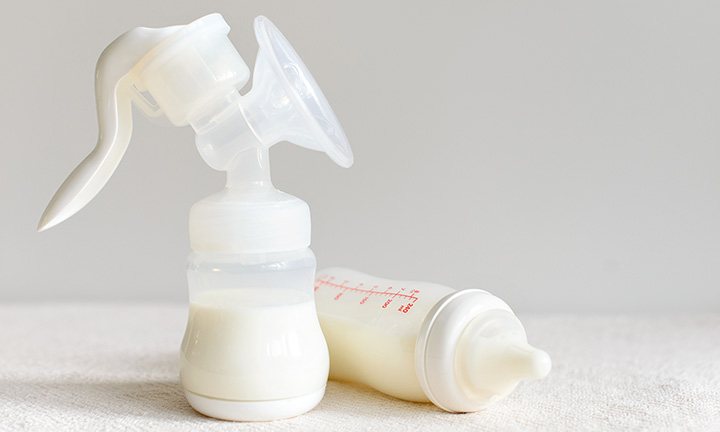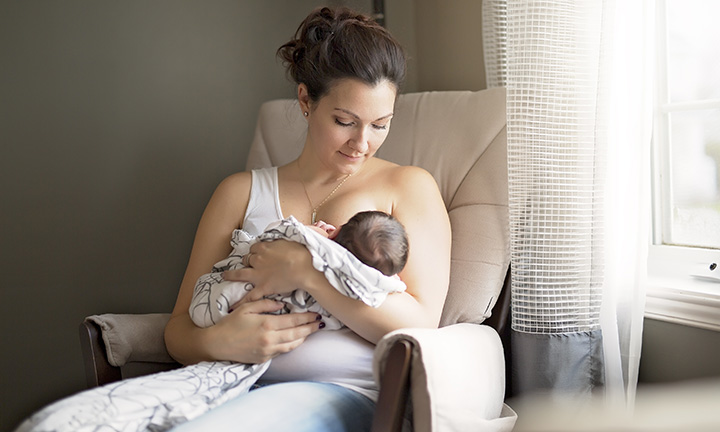
When to Wean a Baby Off Breastmilk


Transitioning your little one from breastfeeding to another form of feeding is a significant milestone. It’s normal to have questions about weaning, such as when to start, how to do it, and what to expect. The decision to begin weaning from breastfeeding is personal. Some parents follow their baby’s cues, while others may need to start due to lifestyle changes, for example, returning to work.
No matter when or why you decide to begin, there are different approaches to how to wean from breastfeeding, and understanding the process may make it smoother for both you and your little one. In this guide, we’ll explore the signs your baby is ready, helpful weaning tips, and what to expect along the way.
What Does Weaning Mean?
Weaning is transitioning your little one from breastfeeding to other sources of nourishment, such as bottle-feeding, cup-feeding, or solid foods. This gradual shift allows your child to adapt to new feeding methods and tastes. Typically, weaning from breastfeeding involves slowly reducing the frequency of nursing sessions, giving your body time to adjust its milk production. This approach may make the transition smoother for both you and your baby.
It's important to note that weaning is a personal decision and may occur at different times for each family. Some parents may wean earlier due to personal circumstances, while others may continue breastfeeding longer.
Observing your little one's cues and consulting with your healthcare provider can help determine the best time to begin the weaning process. Remember, weaning is a significant milestone in your baby's development. Approaching it gradually and with patience may help ensure a positive experience for you and your little one.
When to Start Weaning
When to stop breastfeeding is a personal decision and looks different for every family. Some children gradually show more interest in solid foods and nurse less, while others may stop breastfeeding suddenly. Parents may also feel ready to wean at different times, depending on their circumstances. Experts recommend exclusive breastfeeding for the first 6 months, followed by a combination of breast milk and solid foods until a baby is at least one year old.
For more details here is a Newborn and Baby Feeding Chart for the 1st Year.
When do babies start to stop drinking breast milk? Many naturally lose interest after their first birthday as they become more independent, walking, talking, and eating more solid foods. Others continue nursing longer, known as extended breastfeeding, which remains a healthy option for parents and children who aren't ready to wean. It also supports a child’s immune system.
So, when should you stop breastfeeding? It doesn’t have to be all-or-nothing. Some parents reduce daytime nursing but continue at night, depending on their schedules. However, timing may also depend on the child—some wean earlier than expected, while others resist.
To keep track of your little one’s progress, explore our Baby Development Milestones.
Baby Development Milestones Watching how your baby grows and develops is an important part of parenthood. Keep track of your little one's progress with our articles! Learn More About Baby Development Milestones
Signs Your Child Is Ready to Be Weaned
Some children are happy to nurse indefinitely, while others show signs that they are ready to wean from breastfeeding.
If you're letting your little one take the lead, look for the clues below, that weaning may begin:
If you notice the signs that your baby doesn't want to breastfeed anymore, you may already be in the early stages of baby-led weaning. However, if your child is not showing signs of readiness, waiting a little longer or transitioning gradually may help ease the process.
Tips on How to Wean Your Baby from Breastfeeding
Weaning is easiest when done gradually, allowing both you and your little one to adjust physically and emotionally. One approach is to drop one feeding session per week until all feedings are replaced with a bottle or cup. If you plan to continue offering pumped breast milk, regular pumping will help maintain your supply. Slowly reducing nursing sessions may also help prevent breast engorgement.
Here are some weaning tips to ease the process:
If your little one resists weaning, distractions such as engaging activities, changes in routine, and offering a cup or snack in place of nursing may help. Some children develop comforting habits like thumb-sucking or a security blanket during this transition, which may be a normal part of adjusting.
How to Wean a Very Attached Toddler
If you want to stop breastfeeding but your baby won't take the bottle, know that some resistance is normal, especially for toddlers emotionally attached to nursing. To ease the transition, shorten nursing sessions before dropping them completely and avoid usual nursing spots or cues. Engaging your little one in activities during feeding times may help.
The emotional bond of breastfeeding is strong, so offer extra hugs and cuddles for comfort. If full weaning from breastfeeding is too difficult, try partial weaning, keeping only morning and bedtime sessions while introducing a cup, bottle, or solid foods during the day. Setting a clear endpoint for nursing and responding to your child's emotions may make the process smoother.
Breastfeeding Weaning Schedule
The weaning process varies for every child, but a gradual transition may help ensure they receive proper nutrition at each stage. The American Academy of Pediatrics (AAP) recommends exclusive breastfeeding for the first six months, followed by a combination of breast milk and solid foods after that.
If you decide to wean before 12 months, infant formula should replace breastfeeding. For children 12 months or older, whole cow’s milk or a fortified soy beverage may be introduced instead of breast milk. The chart below provides a simple guide to help navigate the breastfeeding-weaning schedule based on your child’s age.
Pampers Experts | Learning with Pampers' Club Experts! Dive into expert-led advice, educational content, and top recommendations! Including our 9-part online birthing classes! Learn More About the Experts!
Times to Avoid Weaning
You might like to hold off on weaning for a little bit if
Symptoms After Stopping Breastfeeding
Weaning from breastfeeding symptoms may include both physical and emotional changes. Breast engorgement is common, and applying cold compresses or expressing small amounts of milk may help relieve discomfort. Avoid excessive pumping to prevent prolonged milk production.
Weaning breastfeeding symptoms may also include mood swings or feelings of sadness due to hormonal shifts. These changes are normal, but if they persist, seeking support from loved ones or a healthcare provider can help.
Risks of Quitting Breastfeeding
Stopping breastfeeding abruptly may have several effects on both the breastfeeding parent and the baby. A gradual approach is often easier, but if weaning needs to happen quickly, being aware of potential effects may help manage the transition.
For the breastfeeding parent
For the baby
Gradual weaning is ideal, but if a quick transition is needed, offering comfort and patience may ease the process.
FAQS AT A GLANCE
There are no proven disadvantages to breastfeeding beyond a year. Many toddlers continue nursing for comfort and immune benefits. As long as both parent and child are comfortable, extended breastfeeding is a healthy choice.
The Bottom Line
The weaning process may be a challenging but rewarding transition for both you and your little one. With patience and flexibility, you can help your child shift from breastfeeding to solid foods and other forms of nourishment in a way that feels natural and comfortable.
Even after weaning, you’ll still be going through plenty of diapers and wipes. With the Pampers Rewards App, you can earn rewards and discounts on Pampers products, making parenting just a little bit easier.
- CDC. "Breastfeeding and Weaning" – cdc.gov
- HealthyChildren.org. "Continuing Breastfeeding Beyond the First Year"
- KidsHealth. "Weaning" – kidshealth.org
- LLLI. "Sudden Weaning: Medical Reasons" – llli.org
- Women’s Health. "Weaning Your Baby" – womenshealth.gov
- WHO. "Breastfeeding: Questions and Answers" – who.int
Read more about Baby
Related Articles
Join a World of Support
through Pregnancy and Parenthood.
TRACK WITH TOOLS
LEARN WITH EXPERTS
GET REWARDED














